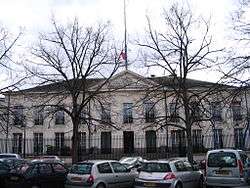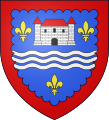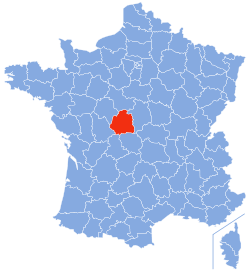Indre
Indre (French pronunciation: [ɛ̃dʁ] (![]()
Indre | |
|---|---|
 Prefecture building of the Indre department, in Châteauroux | |
 Flag  Coat of arms | |
 Location of Indre in France | |
| Coordinates: 46°46′N 1°36′E | |
| Country | France |
| Region | Centre-Val de Loire |
| Prefecture | Châteauroux |
| Subprefectures | Le Blanc La Châtre Issoudun |
| Government | |
| • President of the general council | Louis Pinton |
| Area | |
| • Total | 6,791 km2 (2,622 sq mi) |
| Population (2016) | |
| • Total | 223,505 |
| • Rank | 85th |
| • Density | 33/km2 (85/sq mi) |
| Time zone | UTC+1 (CET) |
| • Summer (DST) | UTC+2 (CEST) |
| Department number | 36 |
| Arrondissements | 4 |
| Cantons | 13 |
| Communes | 241 |
| ^1 French Land Register data, which exclude estuaries, and lakes, ponds, and glaciers larger than 1 km2 | |
History
| Year | Pop. | ±% p.a. |
|---|---|---|
| 1791 | 229,768 | — |
| 1801 | 205,628 | −1.10% |
| 1806 | 204,721 | −0.09% |
| 1821 | 230,273 | +0.79% |
| 1831 | 245,289 | +0.63% |
| 1841 | 253,076 | +0.31% |
| 1851 | 271,938 | +0.72% |
| 1861 | 270,054 | −0.07% |
| 1872 | 277,693 | +0.25% |
| 1881 | 287,705 | +0.39% |
| 1891 | 292,868 | +0.18% |
| 1901 | 288,788 | −0.14% |
| 1911 | 287,673 | −0.04% |
| 1921 | 260,535 | −0.99% |
| 1931 | 247,912 | −0.50% |
| 1936 | 245,622 | −0.19% |
| 1946 | 252,075 | +0.26% |
| 1954 | 247,436 | −0.23% |
| 1962 | 251,432 | +0.20% |
| 1968 | 247,178 | −0.28% |
| 1975 | 248,523 | +0.08% |
| 1982 | 243,191 | −0.31% |
| 1990 | 237,510 | −0.30% |
| 1999 | 231,139 | −0.30% |
| 2006 | 232,959 | +0.11% |
| 2016 | 223,505 | −0.41% |
| source:[1] | ||
Indre is one of the original 83 departments created during the French Revolution on 4 March 1790, by order of the National Constituent Assembly.[2] The new departments were to be uniformly administered and approximately equal in size and population to one another. The department was created from parts of the former provinces of Berry,[2] Orléanais, La Marche and Touraine.[3]
Before the Roman conquest, the Celtic Bituriges tribe occupied an area that included Indre, Cher, and part of Limousin. Their capital was Avaricum (Bourges), and another important settlement was at Argenton-sur-Creuse. The area then became part of Roman Gaul after its conquest by Julius Caesar around 58 BC, and enjoyed a period of stability. Following the collapse of the Roman Empire in the West, the Frankish tribes living in Gaul were united under the Merovingians, and succeeded in conquering most of the country in the sixth century AD. From this time, the Franks controlled most of Gaul and the Carolingian Empire was the last stage of their rule. The Carolingian dynasty reached its peak with the crowning of Charlemagne and after his death in 814, it began to fragment. The Carolingian territories were divided into three sections in 843 at the Treaty of Verdun, and the area that is now the department of Indre, became part of West Francia. In 869, the king of Middle Francia died without leaving a legitimate heir, and eventually part of that kingdom was added to West Francia to effectively form the medieval Kingdom of France.[4]
A castle was built at Châteauroux in the late tenth century. In the eleventh century, the lords of Châteauroux were powerful in the region; their "principality" covered two thirds of the current Department of Indre and they had their own coinage.[5]
Geography
Indre is a department in central France and is part of the region of Centre-Val de Loire. The capital and largest town in the department is Châteauroux. To the north of Indre lies Loir-et-Cher, to the east Cher, to the south lies Creuse and Haute-Vienne, to the southwest lies Vienne, and to the northwest lies Indre-et-Loire. Most of the department is relatively level plains in the broad Loire Valley.[6]
The area of the department is 5,880 km2 (2,270 sq mi) and it is some 100 km (62 mi) from north to south and some 90 km (56 mi) wide. The land is undulating and slopes gently towards the northwest. The main rivers are the Creuse, the Claise and the Indre.[7] The Creuse, a tributary of the Vienne, is 264 kilometres (164 mi) long and has been impounded in several places; at the time it was built in 1926, the Eguzon Dam was the largest dam in Europe.[8] The Claise is 88 kilometres (55 mi) long and is a tributary of the Creuse. The Indre is a longer waterway and flows centrally through the department from south to north, through the major towns of La Châtre, Châteauroux and Loches. It is a tributary of the Loire, joining it at Chinon in the neighbouring department of Loir-et-Cher.[7]
Indre is divided into four natural regions; North Boischaut is undulating land with an altitude between 80 and 215 m (260 and 710 ft) and occupies the northeast of the department, South Boischaut is hilly and lies in the south and southeast, a marshy tract of land known as Brenne is in the southwestern part of the department, and the flat, dry, flinty limestone plateau of Champagne berrichonne is in the east and continues into Cher. The highest point of the department is near the town of Pouligny-Notre-Dame where the land rises to 459 m (1,506 ft) above sea level.[6] The department is made up of 680,910 ha (1,682,600 acres) of land of which 401,535 ha (992,210 acres) are under arable cropping, 85,305 ha (210,790 acres) are grassland, 67,423 ha (166,610 acres) are woodland, 18,110 ha (44,800 acres) are under grapes and 18,273 ha (45,150 acres) are gardens and orchards. The remaining land is heathland, urban land and waterways.[7]
The economy is mostly agricultural. In the past many sheep were raised in the department and woollen yarn was the main manufactured product. There is also a linen industry as well as the manufacture of hosiery and paper. The department has some minerals in the form of coal, iron, stone, marble and clay.[7]
Politics
The President of the General Council is Louis Pinton of the Union for a Popular Movement.
| Party | seats | |
|---|---|---|
| • | Miscellaneous Right | 9 |
| • | Union for a Popular Movement | 8 |
| Socialist Party | 7 | |
| • | New Centre | 2 |
Current National Assembly Representatives
| Constituency | Member[9] | Party | |
|---|---|---|---|
| Indre's 1st constituency | François Jolivet | La République En Marche! | |
| Indre's 2nd constituency | Nicolas Forissier | The Republicans | |
Tourism
Châteauroux, the capital of the department, is a historic town. It was originally called "Château Raoul", the present day château which now houses the préfecture being built on the site of a castle constructed in the tenth century by Raoul le Large, lord of Déols. In 1188 the castle was held by Philippe Auguste who was concerned in protecting the drapery business centred in the town and along the banks of the River Indre from fraud. From 1612 to 1736 it was a duchy of the House of Condé and from 1742 to 1744 was under the control of the Marquise de la Tournelle.[10] The Indre department has two villages which have been classified among the most beautiful villages of France: Saint-Benoît-du-Sault and Gargilesse-Dampierre.

- Le Blanc

See also
References
- Site sur la Population et les Limites Administratives de la France
- Schama, Simon (1989). Citizens: A Chronicle of the French Revolution. New York: Knopf.
- Chisholm, Hugh, ed. (1911). . Encyclopædia Britannica. 14 (11th ed.). Cambridge University Press. p. 501.
- Nelson, Janet L. (1996). The Frankish World, 750–900. A&C Black. pp. 133–144. ISBN 978-1-85285-105-7.
- Archives départementales de l’Indre, Berry médiéval : à la découverte de l’Indre au Moyen Âge, catalogue d’exposition, Châteauroux, Archives départementales de l’Indre, 2009.
- Philips' Modern School Atlas. George Philip and Son, Ltd. 1973. pp. 42–43. ISBN 0-540-05278-7.
- The Encyclopædia Britannica, or, Dictionary of arts, sciences, and general literature. Adam & Charles Black. 1856. pp. 376–377.
- "Eguzon: Creuse's River Valley". L'Ecole Buissonniaire. Retrieved 29 September 2015.
- http://www.assemblee-nationale.fr/
- Scholastic Library Publishing (2005). Encyclopedia Americana: Cathedrals to Civil War. Scholastic Library Pub. p. 334. ISBN 978-0-7172-0138-9.
External links
![]()
- (in French) Prefecture website
- (in French) General Council website
- Indre at Curlie
- (in French) http://www.indrenature.net/